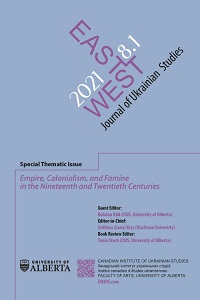Food Supply, Starvation, and Food As a Weapon in the Camps and Ghettos of Romanian-Occupied Bessarabia and Transnistria, 1941-44
Food Supply, Starvation, and Food As a Weapon in the Camps and Ghettos of Romanian-Occupied Bessarabia and Transnistria, 1941-44
Author(s): Paul A. ShapiroSubject(s): History of the Holocaust, History of Antisemitism
Published by: Canadian Institute of Ukrainian Studies at The University of Alberta
Keywords: Bessarabia; Transnistria; Romania; Holocaust; Roma; starvation;
Summary/Abstract: The Romanian regime of wartime leader Ion Antonescu concentrated the Jews of Bessarabia and Bukovyna in transit camps and ghettos, and then deported them to the Romanian-administered territory between the Dnister and Buh rivers, in southwestern Ukraine. Of approximately 160,000 Romanian Jews deported to “Transnistria,” only 50,000 survived the ordeal. The Romanians, with local Volksdeutsch and Ukrainian collaborators, also massacred and were otherwise responsible for the death of approximately 150,000 local Ukrainian Jews, including the large Jewish community of Odesa. While not comparable to the Jews in number, deported Romanian Roma and local Roma were also subjected to physical brutality, forced labour, and incarceration. Famine and starvation did not cause all Jewish and Roma deaths in Bessarabia and Transnistria. Mass executions exacted a huge toll. So did exposure to the elements, exhaustion, and typhus. Still, while there was no famine in the region, starvation was a permanent presence. Romanian authorities controlled the food supply and denied it to their targeted victims. This article describes the steps taken by Romanian occupation authorities to isolate Jews and Roma; to limit the flow of food supplies to them; to prevent them from accessing food in local markets; and to prevent help that might have been offered by those local civilians who took pity on the starving victims. Official documentation and testimonies of both officials and survivors provide a vivid picture of the consequences. Specific cases reveal factors that made the situation in one locality better or worse than that in another, or that caused a situation to improve or deteriorate. Variations notwithstanding, however, all sources lead to the conclusion that Romania’s goal was to eliminate the Jews and reduce the Roma population. This made starvation, the use of “food as a weapon,” an acceptable element of state policy.
Journal: East/West: Journal of Ukrainian Studies (EWJUS)
- Issue Year: 8/2021
- Issue No: 1
- Page Range: 43-80
- Page Count: 38
- Language: English

